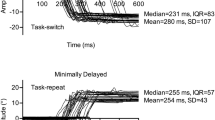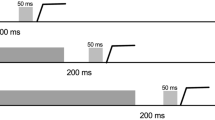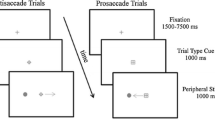Abstract
Several cognitive processes are involved in task-switching. Using a prosaccade/antisaccade paradigm, we manipulated both the interval available for preparation between the cue and the target and the predictability of trial sequences, to isolate the contributions of foreknowledge, an active switching (reconfiguration) process, and passive inhibitory effects persisting from the prior trial. We tested 15 subjects with both a random and a regularly alternating trial sequence. Half of the trials had a short cue–target interval of 200 ms, and half a longer cue–target interval of 2,000 ms. When there was only a short preparatory interval, switching increased the latencies for both prosaccades and antisaccades. With a long preparatory interval, switching was associated with a smaller latency increase for prosaccades and, importantly, a paradoxical reduction in latency for antisaccades. Foreknowledge of a predictable sequence did not allow subjects to reduce switch costs in the manner that a long preparatory cue–target interval did. In the trials with short preparatory intervals, the effects on latency attributable to active reconfiguration processes were similar for prosaccades and antisaccades. We propose a model in which the passive inhibitory effects that persist from the prior saccadic trial are due not to task-set inertia, in which one task-set inhibits the opposite task-set, but to inhibition of the saccadic response-system by the antisaccade task, to account for the paradoxical set-switch benefit for antisaccades at long cue–target intervals. Our findings regarding foreknowledge show that previous studies used to support task-set inertia may have conflated the effects of both active reconfiguration and passive inhibitory processes on latency. While our model of response-system plasticity can explain a number of effects of dominance asymmetry in switching, other models fail to account for the paradoxical set-switch benefit for antisaccades.







Similar content being viewed by others
References
Allport A, Styles E, Hsieh S (1994) Shifting intentional set: exploring the dynamic control of tasks. In: Umiltà C, Moscovitch M (eds) Attention and performance, 15th edn. Erlbaum, Hillsdale, NJ, pp 421–452
Barton J, Cherkasova M, Lindgren K, Goff D, Manoach D (2005) What is perseverated in schizophrenia? Evidence of abnormal response plasticity in the saccadic system. J Abnorm Psychol 114:75–84
Cherkasova M, Manoach D, Intriligator J, Barton J (2002) Antisaccades and task-shifting: interactions in controlled processing. Exp Brain Res 144:528–537
De Jong R (2000) An intention-activation account of residual switch costs. In: Monsell S, Driver J (eds) Control of cognitive processes: attention and performance, 18th edn. MIT, Cambridge, MA, pp 35–70
Dorris M, Munoz D (1998) Saccadic probability influences motor preparation signals and time to saccadic inhibition. J Neurosci 18:7015–7026
Dorris M, Paré M, Munoz D (2000) Immediate neural plasticity shapes motor performance. J Neurosci 20:RC52
Everling S, Munoz DP (2000) Neuronal correlates for preparatory set associated with pro-saccades and anti-saccades in the primate frontal eye field. J Neurosci 20:387–400
Everling S, Dorris MC, Klein RM, Munoz DP (1999) Role of primate superior colliculus in preparation and execution of anti-saccades and pro-saccades. J Neurosci 19:2740–2754
Fecteau J, Munoz D (2003) Exploring the consequences of the previous trial. Nat Rev Neurosci 4:435–443
Fecteau J, Au C, Armstrong I, Munoz D (2004) Sensory biases produce alternation advantage found in sequential saccadic eye movement tasks. Exp Brain Res 159:84–91
Forbes K, Klein R (1996) The magnitude of the fixation offset effect with endogenously and exogenously controlled saccades. J Cogn Neurosci 8:344–352
Hallett P (1978) Primary and secondary saccades to goals defined by instructions. Vision Res 18:1279–1296
Hunt A, Klein R (2002) Eliminating the costs of task set reconfiguration. Mem Cogn (in press)
Kalesnykas R, Hallett P (1987) The differentiation of visually guided and anticipatory saccades in gap and overlap paradigms. Exp Brain Res 68:115–121
Manoach DS, Lindgren KA, Cherkasova MV, Goff DC, Halpern EF, Intriligator J, Barton JJS (2002) Schizophrenic subjects show deficient inhibition but intact task-switching on saccadic tasks. Biol Psychiatry 51:816–825
Manoach D, Lindgren K, Barton J (2004) Deficient saccadic inhibition in Asperger’s disorder and the social-emotional processing disorder. J Neurol Neurosurg Psychiatry 75:1719–1726
Meiran N (1996) Reconfiguration of processing mode prior to task performance. J Exp Psychol Learn Mem Cogn 22:1423–1442
Meiran N (2000) Modeling cognitive control in task switching. Psychol Res 63:234–249
Meiran N, Chorev Z, Sapir A (2000) Component processes in task switching. Cognit Psychol 41:211–253
Monsell S, Yeung N, Azuma R (2000) Reconfiguration of task-set: is it easier to switch to the weaker task?. Psychol Res 63:250–264
Munoz D, Everling S (2004) Look away: the anti-saccade task and the voluntary control of eye movement. Nat Rev Neurosci 5:218–228
Nieuwenhuis S, Monsell S (2002) Residual costs in task switching: testing the failure-to-engage hypothesis. Psychon Bull Rev 9:86–92
Rogers RD, Monsell S (1995) Costs of a predictable switch between simple cognitive tasks. J Exp Psychol Gen 124:207–231
Sohn M-H, Anderson J (2001) Task preparation and task repetition: two-component model of task-switching. J Exp Psychol Gen 130:764–778
Tornay FJ, Milan EG (2001) A more complete task-set reconfiguration in random than in predictable task switch. Q J Exp Psychol A 54:785–803
Wylie G, Allport A (2000) Task switching and the measurement of “switch costs”. Psychol Res 63:212–233
Yeung N, Monsell S (2003) Switching between tasks of unequal familiarity: the role of stimulus- attribute and response-set selection. J Exp Psychol Hum Percept Perform 29:455–469
Author information
Authors and Affiliations
Corresponding author
Rights and permissions
About this article
Cite this article
Barton, J.J.S., Greenzang, C., Hefter, R. et al. Switching, plasticity, and prediction in a saccadic task-switch paradigm. Exp Brain Res 168, 76–87 (2006). https://doi.org/10.1007/s00221-005-0091-1
Received:
Accepted:
Published:
Issue Date:
DOI: https://doi.org/10.1007/s00221-005-0091-1




